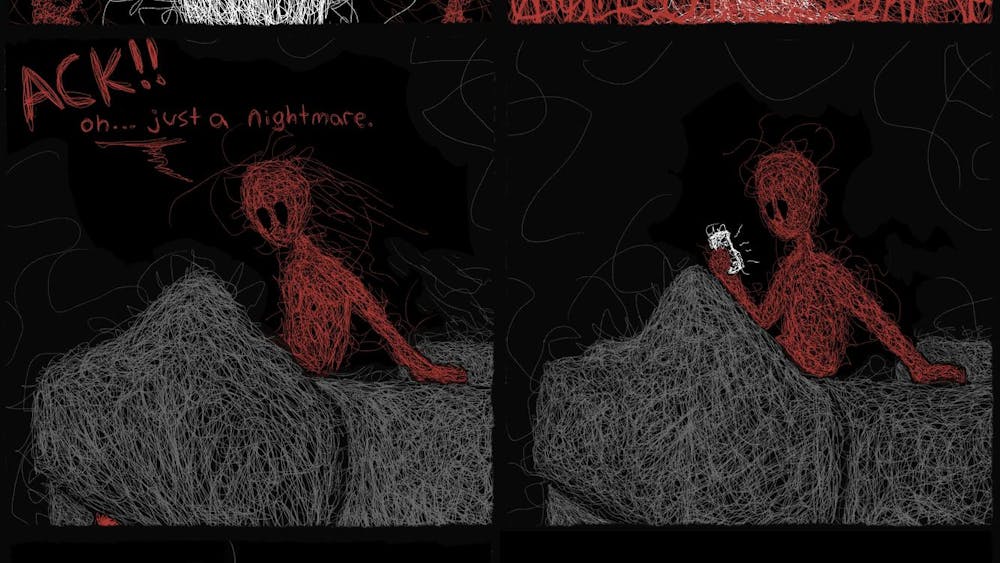Move over Aesop, there’s a new fable prince in the land, and he’s snarky, sarcastic and full of satire.
David Sedaris is easily the champ of cheek. His novel, “Squirrel
Seeks Chipmunk,” contains stories of morality that are more like short, easy-to-read slaps in the face. Presented with childish simplicity and eerie exactness, Sedaris uses animals to veil the fact that his book chronicles the inane flaws of humanity. Each tale brilliantly illustrates one of our many shortcomings, such as pandering, ignorance, self-centeredness, racism, susceptibility, blindness and love. This book will make you second guess everything you say, do and think.
With the titular characters, the squirrel and the chipmunk, it starts with a first date. Sitting across from each other at an intimate table, they discuss acorns, parasites, jazz and the crime of being a dog. After two weeks, they have run out of things to talk about, but still meet out of habit, pretending to be soulmates. Eventually, the chipmunk’s family convinces her that the two have nothing in common except for their rodent-hood and she ends the relationship.
Years later, as age has tinted her memories pink and she has forgotten the lack of commonalities, the chipmunk cannot recall why the relationship did not last. This is an obvious nod at the ridiculous phenomenon of “the one who got away.” It sure is funny how time has a way of “Photoshopping” our memories.
Another fable, actually the first of the series, including a baboon and a cat, warns us of the danger of pandering. The baboon, in this instance, is a hairdresser and her client, the cat, has come to get groomed for a party. While working, the stylist gossips as stylists tend to do.
She talks about weddings and harpists and penciling “I Dos,” but everywhere she turns the conversation, she runs into a wall. She mentions how tacky writing your own vows is, and the cat prickles because she wrote her own vows. She makes fun of a harpist, and the cat is insulted because she had a harpist at her wedding. Finally, desperate to keep her tip and thinking it safe territory, the baboon spouts out, “I hate dogs. Simply cannot stand them.”
At first, the cat is suspicious, wondering why this particular topic was brought up out of the blue, and the baboon explains that she was just remembering a past customer that she refused because she would not make “conversation with anyone who licks his own ass.” Needless to say, this elaboration did not go over well with the cat, but I will leave you to wonder if the baboon managed to wiggle out of this feral quicksand.
As spooky as the author’s moral insight is, Ian Falconer’s illustrations are just as chilling. From a squirrel and a chipmunk imbibing at a romantic table set for two and gazing longingly into each other’s eyes to a pink skinned mink speaking in front of a group of alcoholic animals, these drawings really drive the point home. To be honest, the stories probably wouldn’t have had quite as powerful of an impact if they were not accompanied with such graphic sketches. The two different media are perfect complements.
Although an easy read, I finished the entire book while sitting in an over-stuffed armchair at Barnes & Noble, “Squirrel Seeks Chipmunk” contains a punch similar to that of an ink pen with the arms and attitude of Mr. T. I learned more perusing this fable collection than I ever did with such Aesop’s tales as “The Ant and the Grasshopper” and “The Boy Who Cried Wolf.”
Don’t get me wrong; I’m certainly not discounting Aesop, but there’s a difference between politely suggesting moralistic behavior and shoving the right thing down our throats. “Squirrel Seeks Chipmunk” is definitely a read that comes with my raving recommendation and a fervent admonition to heed Sedaris’ hidden advice.










